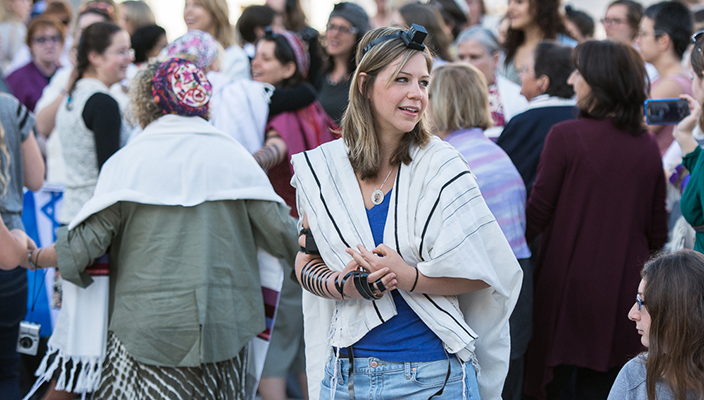
Prayer is a central tenet of Judaism. Jews pray as a way to connect with the Divine, chant ancient poetry, and join with others in community during weekday prayer, Shabbat, and other holidays. Although prayer can be done without the use of ritual items, some Jews find deep spiritual meaning in wearing special items to enhance this sacred experience.
Let’s take a look at some of these items.
Skullcaps (Yarmulkes)
Skullcaps (kippah is the singular, kippot is the plural in Hebrew) are head coverings that are most often round and relatively small, covering only the top or back of the head. Historically kippot were worn by Jewish men and boys during worship (and at other times) as a sign of respect to God.
In Reform congregations today, anyone may wear kippot if they choose to do so, as part of their personal spiritual practice, a sign of respect, or to help them achieve a special frame of mind for spirituality, or prayerfulness. Wearing a kippah is not required – for Jews or for people from other faith or cultural traditions – although visitors may opt to do so as a sign of respect. Some people secure their kippah to their head with bobby pins or metal hair clips. For those who do not, if their kippah falls to the ground, some will kiss it before placing it back on their head.
Congregations often have kippot available in a small basket or other container near the entrance to the worship space. While the kippot provided by congregations tend to be plain and black, Judaica stores and online retailers sell a wide variety of kippot in different colors and materials to suit all tastes. In addition to scenes of Jerusalem, Jewish stars, and Hebrew names, other designs, such as sports logos, cartoon characters, flags, and more may adorn kippot. Often, special kippot are made for life cycle events such as baby namings, b’nei mitzvah, and weddings.
Prayer Shawls
A tallit (tallitot is the plural in Hebrew) is a large shawl with eight tzitzit (fringes) on each corner that is typically worn during worship services on Shabbat and holiday mornings by anyone who has already become b’nei mitzvah and has reached Jewish adulthood. The fringes are intended to serve as a visual reminder of the mitzvot (commandments) God gave the Jewish people, as detailed in Numbers 15:37-40:
"The Eternal One said to Moses as follows: Speak to the Israelite people and instruct them to make for themselves fringes on the corners of their garments throughout the ages; let them attach a cord of blue to the fringe at each corner. That shall be your fringe; look at it and recall all the commandments of the Eternal and observe them, so that you do not follow your heart and eyes in your lustful urge. Thus you shall be reminded to observe all My commandments and to be holy to your God."
Because of the direction to “look at it,” tallitot are worn at worship services only when there is daylight and the fringes can be seen.
Later, in Deuteronomy 22:12, we read: "You shall make tassels on the four corners of the garment with which you cover yourself."
Tallitot also are worn on erev Yom Kippur (the start of Yom Kippur, which, like all Jewish holidays, begins at sundown) because historically, the opening prayer of the service, , which ushers in the holiest day on the Jewish calendar, is chanted just before sundown, when the fringes are still visible. Prayer leaders may wear a tallit on Friday nights to distinguish themselves as the service leader.
Most tallitot include an atarah (crown) along the top where the tallit rests at the neck. The atarah is a point of additional decoration, frequently featuring beautiful and elaborate embroidery. The most common design element for an atarah is the Hebrew text of the blessing for donning a tallit. Alternatively, they may feature a quote from the Torah or another sacred text that has special meaning for the tallit’s owner.
The fringes of a tallit are white, or white with two blue threads. The shawls frequently are white with blue stripes to match the colors of the fringes. The shawl comes in two styles: long and thin, which is worn hanging about the neck; and large and square-ish, which is worn across the shoulders, more like an actual shawl. Judaica stores and online retailers sell a wide variety of tallitot in different colors, fabrics, and sizes to suit all tastes. Young people often receive their first tallit as a gift on their b’nei mitzvah.
As with kippot, wearing a prayer shawl is optional. Like kippot, congregations frequently provide tallitot for individuals who wish to wear one during daytime worship.
Individuals who opt to wear tallit during worship can follow these steps to put it on:
- Unfold the tallit and hold it spread wide in front of you. If the tallit has an atarah, make sure the atarah is at the top of the garment and facing you.
- If you wish, recite this meditation before saying the blessing on the mitzvah of wrapping oneself in a tallit:
בָּרְכִי נַפְשִׁי אֶת יְיָ, יְיָ אֱלֹהַי גָּדַֽלְתָּ מְאֹד, הוֹד וְהָדָר לָבָֽשְׁתָּ. עֹֽטֶה אוֹר כַּשַּׂלְמָה, נוֹטֶה שָׁמַֽיִם כַּיְרִיעָה
Bar'chi nafshi et Adonai, Adonai Elohai, gadalta m’od, hod v’hadar lavashta. Oteh or kasalmah, noteh shamayim kay’riah.
Bless, Adonai, O my soul!
Adonai my God, how great You are.
You are robed in glory and majesty,
wrapping Yourself in light as in a garment,
spreading forth the heavens like a curtain.
- Recite the blessing for donning a tallit. If you wish, when you are finished reciting the blessing, bring each hand to your lips and kiss the fabric of the tallit.
- Optional step: Briefly wrap the tallit around you so that it covers your head and shoulders. Hold it there for a count of three before releasing and going on to settle the tallit in a more wearable position on your shoulders.
Many people choose to perform this step to be sure they truly are “wrapping” themselves in the commandments and giving themselves time to bring focus to their upcoming prayers.
- For a long, thin tallit: drape the tallit across the back of your neck and bring the rest of the fabric forward over your shoulders so that the four fringes hang evenly in front of you.
Many people who wear this style tallit fold it in half lengthwise so the four fringes hang in pairs.
For a large, square-ish tallit: Wrap the tallit around you like a cape. Position the atarah against the back of your neck, letting the tallit fall over your shoulders with the tzitzit draped along both the front and back of your body. Extend one arm under the shawl, grasp the front corner, and bring your hand up to your shoulder, folding the tallit back on itself. Repeat on the opposite side.
TEFILLIN
Tefillin, sometimes called “phylacteries,” consist of straps and two black leather boxes that some Jews wear during weekday morning services. Classically, they were only worn by Jewish men over age 13. In liberal Jewish communities, Jewish adults of any gender may wear tefillin as part of their prayer practice.Tefillin are not worn on chagim (festivals), but may be worn on a festival’s intermediate days (chol hamoed). Tefillin are not widely used by Reform Jews.
The boxes contain parchments inscribed with the Torah verses that command Jews to bind its words upon our arms and heads (Exodus 13:1–10, Exodus 13:11–16, Deuteronomy 6:4–9, and Deuteronomy 11:13-21). To symbolize binding these sacred words (known as laying tefillin), wearers place one box on the bicep and wrap the strap around their arm and hand in a set pattern, and one on the head just above the hairline bound at the back of the neck. (Hair should not be wet when laying tefillin because moisture can warp the leather of the box on your head.)
To lay tefillin, follow these steps:
- Place the arm tefillin box on your bicep. If you are right-handed, place it on your left bicep. If you are left-handed, place it on your right arm.
- Before tightening the strap, recite this blessing:
בָּרוּךְ אַתָּה יְיָ אֱלֹהֵֽינוּ מֶֽלֶךְ הָעוֹלָם, אֲשֶׁר קִדְּשָֽׁנוּ בְּמִצְוֹתָיו, וְצִוָּֽנוּ לְהָנִֽיחַ תְּפִלִּין.
Baruch atah Adonai, Eloheinu melech ha’olam, asher kid’shanu b’mitzvotav vitzivanu l’haniach tefillin.
Blessed are You, Adonai our God, Sovereign of the universe, who hallows us with mitzvot, and commanded us to place tefillin.
- Wrap the strap around your arm seven times. The Sephardic custom is to wrap it away from the torso, and the Ashkenazic custom is to wrap toward the torso but do what feels most comfortable for you.
Wrap the remaining strap around the center of your hand, as many times as necessary to hold it out of the way. It doesn’t need to be secure, as you will re-wrap it momentarily.
- Recite the following blessing:
בָּרוּךְ אַתָּה יְיָ אֱלֹהֵֽינוּ מֶֽלֶךְ הָעוֹלָם, אֲשֶׁר קִדְּשָֽׁנוּ בְּמִצְוֹתָיו, וְצִוָּֽנוּ עַל מִצְוַת תְּפִלִּין.
Baruch atah Adonai, Eloheinu melech ha’olam, asher kid’shanu b’mitzvotav vitzivanu al mitzvat tefillin.
Blessed are You, Adonai our God, Sovereign of the universe, who hallows us with mitzvot, and commanded us regarding the mitzvah of tefillin.
- Place the head tefillin box on your head, centered above your eyes, with the bottom edge of the box at the top of your forehead. The knot in the straps should be centered at the base of your skull where your neck meets your head.
- Drape the two straps of the head tefillin down your chest, one on either side, and straighten them so the black side faces outward.
- Ashkenazi custom includes reciting this blessing:
בָּרוּךְ שֵׁם כְּבוֹד מַלְכוּתוֹ לְעוֹלָם וָעֶד.
Baruch shem k’vod malchuto l’olam vaed.
Blessed is God’s glorious majesty forever and ever. - One minhag (custom) is to wrap the arm strap around your middle finger’s upper knuckle once, then twice around the lower knuckle extending across your ring finger and pinky.
- Recite this verse from Hosea 2:21-22:
וְאֵרַשְׂתִּיךְ לִי לְעוֹלָם, וְאֵרַשְׂתִּיךְ לִי בְּצֶֽדֶק וּבְמִשְׁפָּט וּבְחֶֽסֶד וּבְרַחֲמִים. וְאֵרַשְׂתִּיךְ לִי בֶּאֱמוּנָה, וְיָדַֽעַתְּ אֶת יְיָ.
V’eirastich li b’tzedek u’v’mishpat u’v’chesed u’v’rachamim
V’eirastich li b’emunah v’yadat et Adonai
I betroth you to me forever. I betroth you to me in righteousness, justice, lovingkindness, and mercy. I betroth you to me in faithfulness – and you shall know God.
- It is then custom to wrap the strap between the thumb and index finger twice across your hand. You can notice that this strap has formed the Hebrew letters shin, dalet, and yud along your hand, spelling out Shaddai, or “God Almighty,” one of the names ascribed to God.
- Continue wrapping the tefillin around your hand and tuck the remainder of the strap underneath the rest. Once you have done so, you’re ready to begin your prayer routine.
Wrapping tefillin straps takes a lot of practice to do well, so don’t be discouraged if it is difficult, uncomfortable, or unstable the first few times you try.
Learn about one rabbi’s experiences with prayer garb in this blog post, "My Relationship with My Tallit and Tefillin."
Learn more by watching this Bimbam video:
Explore Jewish Life and Get Inspired
Subscribe for Emails
